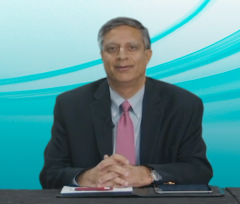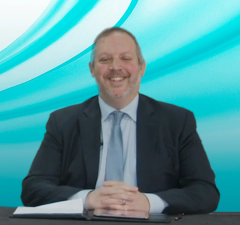
Transplant-Ineligible Multiple Myeloma: The SWOG0777 Study
Nisha Joseph, MD, presents the case of a 78-year-old man with transplant-ineligible multiple myeloma and discusses treatment strategy.
Episodes in this series

Sagar Lonial, MD: Dr Joseph, you’ve got another case to present for us.
Nisha Joseph, MD: Let’s go to the second patient case. This is the 78-year-old man who presented to the ED [emergency department] at the end of 2019 with worsening lower back pain for 3 months, now with onset of lower extremity weakness. Laboratory tests are notable for a calcium of 10.5 mg/dL, SPEP [serum protein electrophoresis] showed a paraprotein of 2.9 g/dL of an IgG kappa, IgG was elevated over 4000 mg/dL, and his free kappa light chain was 636 mg/L, with a free light chain ratio over 100. A bone marrow biopsy was done and showed 25% plasma cells, with a normal male karyotype. FISH [fluorescence in situ hybridization] noted some hyperdiploidy. MRI lumbar spine showed diffuse osseous disease with multiple compression fractures with large enhancing lesions in L3 with extension into the epidural space.
The patient received palliative radiation to that lesion in L3 and was started on bortezomib and dexamethasone inpatient, with improvement of his pain, and discharged home. He then followed up in the clinic and was started on RVd [lenalidomide, bortezomib, dexamethasone]–lite at the beginning of 2020. He was deemed transplant ineligible at that time due to several comorbidities and his performance status. He was dosed at a dose-reduced lenalidomide of 15 mg on days 1 through 21, weekly bortezomib, and weekly dexamethasone reduced to 20 mg, all on 28-day cycles. He completed 8 cycles of RVd-lite, achieved a CR [complete response] after cycle 4, and at that time was transitioned to lenalidomide maintenance alone in September of 2020. I just saw this patient. He remains in CR and is doing well on lenalidomide maintenance.
Sagar Lonial, MD: It brings up the idea and concepts around PFS [progression-free survival] benefit and potentially overall survival benefit of the different regimens we have. When we think about RVd as a backbone, the 2 trials that looked at this without a transplant are the SWOG S0777 trial, where the median PFS was around 2½ to 3 years, somewhere in that ballpark, and the ENDURANCE [NCT01863550] trial that you mentioned, which also looked at nontransplant RVd vs KRd [carfilzomib, lenalidomide, dexamethasone]. The median PFS is somewhere around 36 months in that one as well, with the hypothesis that K [carfilzomib] was going to be significantly better in a standard-risk patient population.
When you compare that with what we saw for MAIA [NCT02252172], the updates that Dr Nooka talked about where the median PFS for all patients was about 60 months or longer—probably longer if you if you look only at the standard-risk folks—there’s a compelling case to be made for using something like daratumumab-lenalidomide-dexamethasone in that patient population. As a group, we’ve adopted that as an important standard.
Dr Nooka, let me ask you this. You’ve made a decision, pushed the button, and you’re going to go with regimen X. What do you consider an adequate treatment response? When do you consider changing treatments vs staying on that same and going with continuous therapy?
Ajay Nooka, MD: This is a great question. There are a couple of things that I take into consideration when I make the determination. No. 1 is the risk status. If it’s a higher-risk patient, historically we’ve seen that it isn’t difficult to attain that response, but it’s difficult to maintain that response. It helps me to maintain that combination treatment for as long as the patient can tolerate it, fully understanding that a transplant-ineligible patient comes with a lot of comorbidities. Diabetes and neuropathy are more common in these patients. If that’s the case, how many bortezomib-based treatments can I give so that I can get the best response and, at the same time, not cause a worsening of this neuropathy?
Those are the things that I take into consideration before making the determination: risk and tolerance. Coming to a standard-risk patient, the earlier I get to a CR—now we have better measurement using MRD [minimal residual disease]—it’s helping us to streamline this to get to the best depths of response so that we can still maintain these responses for longer without having to give those combination treatments.
Sagar Lonial, MD: That’s an important way to think about using the paradigm of choosing your regimen to try to maximize the depth of response early on.
Transcript edited for clarity.
Newsletter
Stay up to date on recent advances in the multidisciplinary approach to cancer.






















































































